

The side streets of Detroit contain some very interesting buildings that are extremely easy to overlook. There are at least two former farm houses currently being used as single-family residences. Both are impressive.
Moses Field was born in Watertown, New York in 1828. His parents moved to Cato, New York where he attended public schools and then went on to graduate from an academy in Victor, New York. At age 16, he moved to Detroit where he became a prosperous man, politician and a significant public leader. Apparently, he got his start in the grocery business in Detroit and then purchased land for development or speculation. Eventually, he operated the Detroit Glass Works and the Detroit Hoop Manufacturing Company. Shortly before his death, he purchased exclusive rights to manufacture pulp from Michigan’s pine forest, a product required for the production of paper.
He was first elected to office to serve as an alderman in Detroit in 1863, a post he held for only two years. In 1872, he was elected as a Republican representative to Congress, but lost his reelection campaign two years later. By 1876, he apparently split with the Republican Party and tried to organize the Greenback Party. He served as a Regent of the University of Michigan for a year or so before his death at age 61 in 1889. Field was one of quite a few prosperous Detroit residents who contributed money to help establish an art museum. He is also credited with the idea of establishing public drinking fountains in Detroit, a development of 1871.
Field apparently owned considerable land in Hamtramck Township, land that was later annexed by Detroit. He created a farm called Linden Lawn and built the Italian Villa style home that you see in the late 1860s. It is a square brick home with a hip roof. I presume that the basement is stone, but has been covered with stucco. Originally, there was a full-width porch across the front of this attractive residence. The interior woodwork is apparently elegant and wood and marble fireplaces were built on each floor. In 1935, the home was converted into two flats. Subsequently, it was converted into the single-family residence you see.
The street in front of the home bears Field’s name, as does nearby Moses Field school at 1100 Sheridan. The Agnes Street that intersects Field is name for his daughter.
The other remaining farm house within Detroit that I know about is the James Smith Farm House at: 2015 Clements.
Architect: Unknown to me
Date of Construction: Late 1860s.
Architectural style: Italian villa
Use in 2006: Private residence
City of Detroit Local Historic District: Established May 7, 1999
State of Michigan Registry of Historic Sites: Not listed
National Register of Historic Places: Not listed
Photograph: Andrew Chandler; July, 2004
Date Description Prepared: October, 2006
Return to City of Detroit Historic Designations